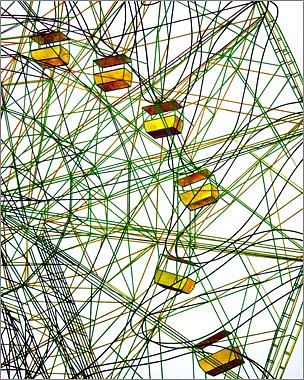
REVIEW: William Steiger in Art in America
May 1, 2005 - Melissa Kuntz
By reducing landscape to simplified forms, New York-based William Steiger creates stark, cool paintings of often-archetypal subject matter. The 11 works (all 2004) in this show depict cable cars, grain elevators, a mill, an aerial landscape or the Coney Island Wonder Wheel—all curiously devoid of human presence. Apart from the legendary amusement park attraction, Steiger provides no reference to a particular locale, time of day or era.
The hard-edge, flat quality of his paint handling is fitting for the mostly architectural forms. Although rendered freehand, the edges are crisp and precise. Color is often more arbitrary than perceptual. In “Blue Mill” (60 by 48 inches), for example, the windows of the all-white edifice are an electric cerulean blue. Steiger's earlier paintings also depict man-made objects—a bridge, a lighthouse, an airplane or signal towers—within a nonspecific landscape, yet, unlike his new work, they do not rely heavily on negative space. In his recent pieces, the untouched gessoed ground is as much part of the image as are the precise shapes painted in oil. In “Elevator V” ( 60 by 48 inches), a row of grain elevators recedes in one-point perspective. The sides of the buildings that are in shadow are rendered in subtly varied values of dove gray; the sunlit areas remain the untouched white of the gessoed ground. Although the image reads correctly, the viewer is left to differentiate where the buildings end and the sky begins.
In a series of paintings of cable cars, ranging from 10 by 8 to 60 by 48 inches, either one or two intense red cars are suspended on cables that enter the composition at one edge and tilt downward, then off the canvas and out of sight. The background is either white gesso or blue “sky,” with no suggestion of where the cars might have originated or where they might be headed. The viewer is invited to imagine what occurs in the space outside of the canvas.
At his best, Steiger plays visual games with the viewer. “The Ride” (60 by 48 inches) is a green and ocher rendering of the Wonder Wheel. Designed by Charles Herman and constructed in 1918-20, the Ferris Wheel-like ride consists of eight stationary cars and 16 others that roll along interior tracks. At first glance, Steiger's painting appears to boast draftsmanlike accuracy, yet upon closer inspection, discrepancies are revealed. The lines delineating the wheel seem to become entangled or follow illogical paths, and the tracks appear to turn back on themselves. Here as elsewhere, Steiger revels both in verisimilitude and in pointing out the inherent artificiality of visual language.
Melissa Kuntz
Download Article (PDF)Back to News
